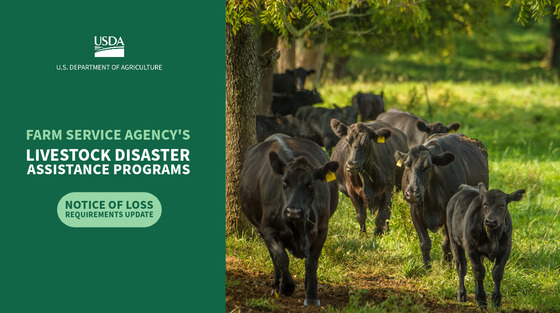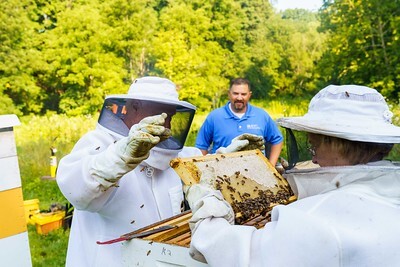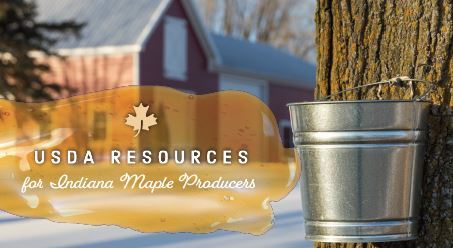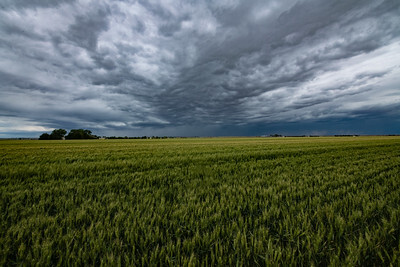
The season of thankfulness is upon us, and I am grateful to our agricultural community for their work through another agricultural season. I am also grateful for our amazing Farm Service Agency (FSA) staff in Indiana, and I hope you are, too! The knowledge and talent they bring to serving the producers and landowners across the state is incredible, and we are successful in our pursuits because of the dedicated team we have in our great state.
It has been a busy time of meetings, conferences, and tradeshows, and I’m hoping to have the opportunity to talk with many of you during the winter months at an upcoming event. One recent highlight was attending the National FFA Convention and representing FSA on a national stage at the tradeshow. Our Indiana FSA employees had an opportunity to speak with FFA members from across the country, and to connect them to FSA, and how a career with the federal government, serving agriculture, might work for them. It is a great pipeline of talent at the county level for our agency.
Ballot counting for County Committee (COC) members is occurring in certain Local Administrative Areas in each of your respective counties. These committee members make important decisions about how federal farm programs are administered locally. We are excited to learn who our new COC members will be this next year.
As the year ends, I want to thank you for the relationship you have with your county office. I wish you and your family a very happy holiday season and cheers to a great new year!
Sincerely In Agriculture –
|
 State Executive Director
 USDA has waived certain notice of loss requirements for 2023 for the Emergency Assistance for Livestock, Honeybees, and Farm-raised Fish (ELAP) and Livestock Indemnity Program (LIP). In an effort to streamline assistance to support access to critical 2023 natural disaster recovery assistance, USDA’s Farm Service Agency (FSA) is waiving the requirement to submit ELAP or LIP notices of loss within a pre-determined number of days for 2023. Instead, producers have the flexibility to submit 2023 notices of loss as soon as possible, once losses are realized, following a natural disaster event or no later than the established annual program application for payment deadlines for each program. FSA county committees are also being asked to re-evaluate 2023 ELAP and LIP late-filed notices of loss to determine if the waiver applies.
Emergency Assistance for Livestock, Honeybees and Farm-Raised Fish
ELAP provides recovery assistance to eligible producers of livestock, honeybee, and farm-raised fish losses due to an eligible adverse weather or loss condition, including blizzards, disease, water shortages and wildfires. ELAP covers grazing and feed losses, transportation of water and feed to livestock and hauling livestock to grazing acres. ELAP also covers certain mortality losses for livestock including honeybees and farm-raised fish as well as honeybee hive losses. ELAP is designed to address losses not covered by other FSA disaster assistance programs.
For 2023, FSA is waiving the regulatory requirement for producers who are eligible for ELAP to file a notice of loss with FSA within 30 calendar days from when the loss first became apparent for livestock and farm-raised fish and 15 calendar days for honeybees. Under this waiver, notices of loss are to be completed by the eligible producer and submitted to FSA no later than the annual program application deadline of January 30 following the program year in which the loss occurred. Therefore, producers who incurred ELAP-eligible losses in 2023, will need to submit a notice of loss by January 30, 2024.
Livestock Indemnity Program
LIP provides disaster recovery assistance to livestock owners and contract growers who experience livestock deaths, in excess of normal mortality caused by eligible loss conditions including adverse weather, disease and attacks by animals reintroduced into the wild by the federal government or protected by federal law, including wolves and avian predators. LIP also helps livestock owners who must sell livestock at a reduced price because of an injury from certain loss conditions.
For 2023, FSA is waiving the regulatory requirement for producers who are eligible for LIP to file a notice of loss within 30 calendar days from when the loss first became apparent. Under this waiver, producers are still required to complete and submit the notice of loss to FSA no later than the annual program payment application date, which is 60 calendar days following the program year in which the loss occurred. The LIP payment application and notice of loss deadline is February 29, 2024, for the 2023 program year.
2023 Disapproved Applications
FSA county committees will review all notices of loss for both ELAP and LIP that were previously disapproved for the 2023 program year due to late filing and re-evaluate them to determine if the waiver applies. To receive ELAP and LIP benefits, producers will still need to file an application for payment by the established program deadline for the 2023 program year. Producers who are unsure about the status of their notice of loss or application for payment, should contact their local FSA county office as soon as possible.
Supporting Documentation
Accurate records and loss documentation are critical following disaster events and are required when filing notices of loss with FSA. Acceptable loss documentation includes:
- Documentation of the number, kind, type, and weight range of livestock that have died, supplemented, if possible, by photographs or video records of ownership and losses.
- Rendering truck receipts by kind, type, and weight - important to document prior to disposal.
- Beginning inventory supported by birth recordings or purchase receipts.
- Documentation from Animal Plant Health Inspection Service, Department of Natural Resources, or other sources to substantiate eligible death losses due to an eligible loss condition.
- Documentation that livestock were removed from grazing pastures due to an eligible adverse weather or loss condition.
- Costs of transporting livestock feed to eligible livestock, such as receipts for equipment rental fees for hay lifts and snow removal.
- Feed purchase receipts if feed supplies or grazing pastures are destroyed.
- Number of gallons of water transported to livestock due to water shortages.
More Information
The improvements to ELAP and LIP build on others made since 2021. This includes ELAP benefits for above normal costs for hauling feed and water to livestock and transporting livestock to other grazing acres during a qualifying drought. FSA also expanded eligible livestock under ELAP, LIP, and the Livestock Forage Disaster Assistance Program, and increased the LIP payment rate for beef, beefalo, bison, and dairy animals less than 250 pounds and most recently beef calves over 800 pounds. Learn about USDA disaster assistance programs on farmers.gov.
On farmers.gov, the Disaster Assistance Discovery Tool, Disaster-at-a-Glance fact sheet and Loan Assistance Tool can help producers and landowners determine disaster protection and recovery program or loan options. For more information about FSA programs, contact your local USDA Service Center.

FSA administers two programs that have specific safety net benefits for producers of honeybees and honey. The Noninsured Crop Disaster Assistance Program (NAP) and the Emergency Assistance for Livestock, Honeybees and Farm-Raised Fish Program (ELAP) assist producers when disasters impact honey production or damage or destroy colonies, hives or honeybee feed.
NAP is designed to reduce financial losses when natural disasters result in lower yields or crop losses, including honey. NAP coverage is equivalent to catastrophic insurance, meaning it covers up to 50 percent of a producer’s normal yield (must have at least a 50 percent loss) at 55 percent of the average market price. The 2018 Farm Bill reinstates higher levels of coverage, from 50 to 65 percent of expected production in 5 percent increments, at 100 percent of the average market price. Producers of organics and crops marketed directly to consumers also may exercise the “buy-up” option to obtain NAP coverage of 100 percent of the average market price at the coverage levels of between 50 and 65 percent of expected production.
The NAP service fee is the lesser of $325 per crop or $825 per producer per administrative county, not to exceed a total of $1,950 for a producer with farming interests in multiple counties.
ELAP covers colony losses, honeybee hive losses (the physical structure) and honeybee feed losses in instances where the colony, hive or feed has been destroyed by a natural disaster or, in the case of colony losses, because of Colony Collapse Disorder. Colony losses must be in excess of normal mortality.
NAP Sales Closing Date
You must apply for NAP coverage by December 31st prior to the year for which you’re seeking coverage.
Colony Reporting
Both the NAP and ELAP programs require you to report the number of colonies you have in production to FSA by January 2, 2024. You must notify FSA within 30 calendar days of changes in the total number of colonies or when honeybees are moved to another county.
Loss Reporting
For ELAP, you should notify FSA within 15 calendar days of when a loss is apparent. January 30, 2024 is the final day to submit 2023 calendar year losses.
For NAP, you should notify FSA within 15 calendar days of when the loss is apparent or no later than January 15, 2024.
To learn more about programs for honey and honeybee producers, contact your local USDA Service Center or visit fsa.usda.gov.
|

Funding Opportunities
USDA’s Farm Service Agency offers funding opportunities to help maple producers start, expand, and maintain their operations.
Farm Storage Facility Loans
FSA’s Farm Storage Facility Loan Program (FSFL) provides low- interest financing so producers can build or upgrade facilities to store certain commodities. Maple sap and maple syrup are both eligible, and equipment and facilities such as sap tanks, certain hauling trucks, and storage space for maple syrup qualify. Eligible facilities and equipment may be new or used, permanently affixed, or portable.
Farm Loan Programs
There are several types of farm loans available to fit your specific business needs. Loan options such as: Farm Operating and Ownership Loans, Microloans, Emergency Loans, Conservation Loans and Youth Loans.
Visit farmers.gov/fund to learn more about funding opportunities for your operation. Through our Farm Loan Discovery Tool, you can answer five quick questions to learn about USDA farm loans that might be right for you.
Conservation Resources
USDA’s Natural Resources Conservation Service (NRCS) offers programs and services that benefit both maple producers and the environment such as the Environmental Quality Incentives Program (EQIP) and the Conservation Stewardship Program (CSP).
NRCS also offers free one-on-one technical assistance to support maple producers throughout the production process. Visit farmers.gov/conserve to learn more about conservation opportunities for your operation.
Recovery Support
USDA’s Farm Service Agency (FSA) and Risk Management Agency (RMA) offer coverage and programs to help you prepare for and recover from natural disasters.
- RMA's Federal crop insurance is administered through RMA to provide a robust and reliable farm safety net.
- FSA’s Noninsured Crop Disaster Assistance Program (NAP) helps producers manage risk through coverage for both crop losses and crop planting that was prevented due to natural disasters.
- You must apply for NAP coverage by December 31st prior to the year for which you’re seeking coverage.
- Through FSA's Tree Assistance Program (TAP), FSA offers financial assistance to eligible orchardists and nursery tree growers to replant or rehabilitate eligible trees, bushes, and vines lost due to natural disasters.
- For Federal Crop Insurance, NAP and TAP - Maple producers are required to report their tap numbers to FSA by January 2, 2024.
Visit farmers.gov/recover to learn more about USDA resources to manage risk and recover from natural disasters. You can use our Disaster Assistance Discovery Tool to learn about USDA disaster assistance programs that might be right for you in five simple steps. For an overview of available disaster assistance, view or download the USDA Disaster Assistance Programs At-A-Glance brochure.
|

In order to maintain program eligibility and benefits, producers must file timely acreage reports. Failure to file an acreage report by the crop acreage reporting deadline may cause ineligibility for future program benefits. FSA will not accept acreage reports provided more than a year after the acreage reporting deadline.
Upcoming acreage reporting deadlines for Indiana:
-
December 15 - Fall Mint and Fall-Seeded Small Grains
-
January 2 – Hives (Honey) and Maple Sap (Taps)
-
January 16 – Apples
FSA has the following policies for acreage reporting:
Reporting Cover Crops:
Cover crop types can be chosen from the following four categories:
- Cereals and other grasses
- Legumes
- Brassicas and other broadleaves
- Mixtures
If the cover crop is harvested for any use other than forage or grazing and is not terminated according to policy guidelines, then that crop will no longer be considered a cover crop and the acreage report must be revised to reflect the actual crop.
Permitted Revision of Intended use After Acreage Reporting Date:
New operators or owners who pick up a farm after the acreage reporting deadline has passed and the crop has already been reported on the farm, have 30 calendar days from the date when the new operator or owner acquired the lease on land, control of the land or ownership and new producer crop share interest in the previously reported crop acreage. Under this policy, appropriate documentation must be provided to the County Committee’s satisfaction to determine that a legitimate operator or ownership and producer crop share interest change occurred to permit the revision.
Reporting Grazing Allotments:
FSA offices can now accept acreage reports for grazing allotments. You will use form “FSA-578” to report grazing allotments as animal unit months (AUMs) using the “Reporting Unit” field. Your local FSA office will need the grazing period start and end date and the percent of public land.
Definitions of Terms
FSA defines “idle” as cropland or a balance of cropland within a Common Land Unit (CLU) (field/subfield) which is not planted or considered not planted and does not meet the definition of fallow or skip row.
Fallow is considered unplanted cropland acres which are part of a crop/fallow rotation where cultivated land that is normally planted is purposely kept out of production during a regular growing season.
More Information
Producers are encouraged to file their acreage reports as soon as planting is completed.
All producers are encouraged to contact their local USDA Service Center for more information on the final planting date for specific crops. The final planting dates vary by crop, planting period and county. The timely planting of a crop, by the final planting date, may prevent loss of program benefits.
For more information, contact your local USDA Service Center or visit fsa.usda.gov.
|

If you want to use the Noninsured Crop Disaster Assistance Program (NAP) organic price and you select the "organic" option on your NAP application, you must report your crops as organic.
When certifying organic acres, the buffer zone acreage must be included in the organic acreage.
You must also provide a current organic plan, organic certificate or documentation from a certifying agent indicating an organic plan is in effect. Documentation must include:
- name of certified individuals
- address
- telephone number
- effective date of certification
- certificate number
- list of commodities certified
- name and address of certifying agent
- a map showing the specific location of each field of certified organic, including the buffer zone acreage
Certification exemptions are available for producers whose annual gross agricultural income from organic sales totals $5,000 or less. Although exempt growers are not required to provide a written certificate, they are still required to provide a map showing the specific location of each field of certified organic, transitional and buffer zone acreage.
For questions about reporting organic crops, contact your local USDA Service Center or visit fsa.usda.gov.
|
If you plan to sell farmland that’s enrolled in CRP, FSA would like to remind you about the terms and conditions of your contract.
Under the CRP program, the original contract (CRP-1) will need to be revised to reflect the change in participants and/or shares on the contract. The new CRP participant(s) must sign a revised contract within 60 calendar days from the date of notification by the county committee or county executive director. If a revised contract isn't signed within the 60-day timeframe, the contract will be terminated with respect to the affected portions of such land and the original CRP participant will be held liable.
If the new landowner elects not to continue the CRP contract, the contract will be terminated. When a contract is terminated, refund is required from the original CRP participant. This refund includes all annual rental payments, all cost share payments, signup incentive payments, and practice incentive payments, plus interest. Liquidated damages are also assessed.
Refunds of payments will not be required in cases where the owner's estate or the heirs do not succeed to the contract. There are other cases that do not require the refund of payments, when a participant loses control of the land, such as eminent domain.
CRP participants should contact their FSA County office if there are any questions regarding the terms and conditions of your CRP contract.

Farm Storage Facility Loans (FSFL) provide low-interest financing so producers can build or upgrade faciliti08es to store commodities. Some storage and handling trucks are eligible for the FSFL. These include:
-
Cold Storage Trucks: A van or truck designed to carry perishable freight at specific temperatures. Cold storage trucks can be ice-cooled or equipped with any variety of mechanical refrigeration systems.
-
Flatbed Trucks: Truck with an open body in the form of a platform with no side walls for easy loading and unloading. These trucks can be categorized into different sizes which range from light, medium, or heavy duty, compact or full-size, or short and expandable beds.
-
Grain Trucks: A piece of farm equipment specially made to accommodate grain products and are traditionally truck chassis units with a mounted grain “dump” body where grain commodities are transported from a field to either a grain elevator or a storage bin.
-
Storage Trucks with a Chassis Unit: Commonly referred to as a box truck, box van or straight truck, is a truck with a cargo body mounted on the same chassis with the engine and cab.
-
Semi-Trucks or Truck Tractors: Any vehicle configuration consisting of a power-unit designed in combination to draw or pull a semi-trailer or farm machinery.
To be eligible for FSFL, the storage and handling truck must be less than 15 years old and have a maximum of four axles with a gross weight rating of 60,000 pounds or less. Pick-up trucks, semi-trucks, dump trucks, and simple insulated and ventilated vans are ineligible for FSFL.
FSFL for storage and handling trucks must be $100,000 or less. FSFL-financed storage and handling trucks must be used for the purpose for which they were acquired for the entire FSFL term.
Eligible commodities include grains, oilseeds, pulse crops, hay, honey, renewable biomass commodities, fruits and vegetables, floriculture, hops, maple sap, milk, cheese, yogurt, butter, eggs, meat/poultry (unprocessed), rye and aquaculture.
For more information or to apply for a FSFL, contact your local FSA Service Center.
|
All requests for assistance must be received by December 31, 2023
There are currently 2 specific Inflation Reduction Act (IRA) programs in place to provide assistance to distressed FSA Farm Loan borrowers.
FSA encourages all borrowers experiencing any financial stress to reach out to the County Office to discuss their eligibility for the following programs.
Cash Flow-Based Assistance
USDA has begun implementing a process to identify whether an operation has sufficient cash flow to make their next scheduled loan payment. Through this procedure, qualifying borrowers can request FSA to cover their next installment due or a recently missed installment. All FSA direct loan borrowers should have received a letter in February 2023 detailing the process for seeking this type of assistance even before they become delinquent.
Borrowers who are within two months of their next installment may seek a cash flow analysis from FSA using a recent balance sheet and operating plan to determine their eligibility.
Borrowers can submit requests for cash flow-based assistance in person at their local FSA office or by sending in a direct request using the farmers.gov 22006 assistance request portal at farmers.gov/ira22006cashflow.
For more information, see the steps in the cash flow-based assistance review process.
Extraordinary Measures Assistance
In May 2023, USDA sent a letter to all FSA direct loan borrowers detailing a new opportunity to receive assistance if they took extraordinary measures to avoid delinquency between February 28, 2020 and October 18, 2022, such as taking on more debt, selling property, or cashing out retirement accounts. The letter provides the specific types of actions that may qualify for assistance and the documentation needed to receive assistance.
Borrowers can submit requests for extraordinary measures assistance in person at their local FSA office or by sending in a direct request using the farmers.gov 22006 assistance request portal at farmers.gov/ira22006request.
All requests for assistance must be received by December 31, 2023. Assistance is subject to funding availability.
For more information, see the steps in the extraordinary measures assistance review process.
 The U.S. Department of Agriculture (USDA) has launched an online application for Direct Loan customers. More than 26,000 customers who submit a Direct Loan application each year can now use an online, interactive, guided application that is paperless and provides helpful features including an electronic signature option, the ability to attach supporting documents such as tax returns, complete a balance sheet and build a farm operating plan. This tool is part of a broader effort by USDA’s Farm Service Agency (FSA) to streamline its processes, improve customers service, and expand credit access.
The online farm loan application replicates the support an applicant would receive when completing a loan application in person with an FSA Farm Loan Officer, while continuing to provide customers with one-on-one assistance as needed. This tool and other process improvements allow farmers and ranchers to submit complete loan applications and reduce the number of incomplete and withdrawn applications.
Through a personalized dashboard, borrowers can track the progress of their loan application. It can be accessed on farmers.gov or by completing FSA’s Loan Assistance Tool at farmers.gov/loan-assistance-tool. To use the online loan application tool, producers must establish a USDA customer account and a USDA Level 2 eAuthentication (“eAuth”) account or a Login.gov account. For the initial stage, the online application tool is only available for producers who will be, or are currently, operating their farm as an individual. FSA is expanding the tools availability to married couples applying jointly and other legal entities in 2024.
Farm Loan Improvement Efforts
FSA has a significant initiative underway to streamline and automate Farm Loan Program customer-facing business processes. For the over 26,000 producers who submit a Direct Loan application to FSA annually, and its 85,000 Direct Loan borrowers, FSA has made improvements this year, including:

The Veterans IN Farming team has announced they are hosting an upcoming workshop in January 2024, designed for veterans interested in exploring homesteading or farming.
The workshop is scheduled for January 19-21, 2024, at Fair Oaks Farms in Fair Oaks, Indiana.
The event will feature guest speakers from the U.S. Department of Agriculture, Purdue University College of Agriculture, Indiana Grown, and Successful Farmers.
Beginner Topics Include: Business Planning, Marketability, Purchasing Real Estate, USDA Resourcing Opportunities, Q and A Panel of Experienced Farmers.
Advance Topics Include: Introduction to Beekeeping, Grant application tips, Rural Farming Opportunities, Farm Economics and QuickBooks, and Managing Farm Stress.
Ticket Stipends are available through the Indiana AgVet Program by enrolling in the program: Contact Linda Tarr at ltarr@hoosieruplands.org or 812-849-4447.
For more information about the Veterans IN Farming 2024 Workshop, please contact Joe Ricker at 262-388-1261 or e-mail him at joericker@ateaseorchard.com.
You may also click HERE for additional information.
|
Navigating filing taxes can be challenging, especially if you are new to running a farm business, participating in disaster programs for first time, or trying to forecast the farm’s tax bill. Receiving funds from USDA through activities such as a conservation program payment or a disaster program is considered farm income that includes a tax liability for farm businesses. USDA technical assistance is free and creates no tax implications.
At the end of the tax year, USDA issues tax forms 1098 and 1099 for farm loans, conservation programs administered by the Farm Service Agency and Natural Resource Conservation Service including the Conservation Reserve Program and Environmental Quality Incentives Program, crop disaster payments, and the Market Facilitation Program. USDA also issues tax forms for recipients of assistance for distressed borrowers, including through Section 22006 of the Inflation Reduction Act.
If you have received tax forms related to your operation, USDA cannot and does not provide tax advice but wants you to be aware of options that may help manage your tax liability. USDA has partnered with experts to provide resources to help you make the right tax decisions for your operation. Monthly webinars are available for registration and to view on demand.

The Tax Estimator Tool is an interactive spreadsheet that producers can download to estimate tax liability. It is for informational and educational purposes and should not considered tax or legal advice. Producers may need to work with a tax professional to determine the correct information to be entered in the Tax Estimator Tool.
We encourage you to visit farmers.gov/working-with-us/taxes for more information on how to find and work with a tax preparer as well as instructions on how to request copies of USDA documents and links to other helpful tax resources.
|
USDA announced loan interest rates for December 2023, which were effective December 1, 2023. USDA’s FSA loans provide important access to capital to help agricultural producers start or expand their farming operation, purchase equipment and storage structures, or meet cash flow needs.
FSA also offers guaranteed loans through commercial lenders at rates set by those lenders.
Check your eligibility for FSA loans by utilizing the Farm Loan Assistance Tool. Find out which of these loans may be right for you by using our Farm Loan Discovery Tool.
Producers can explore available options on all FSA loan options at fsa.usda.gov or by contacting your local USDA Service Center.
2023 Indiana FSA Important Deadline Dates
2024 Indiana FSA Important Deadline Dates
December 15 - Final Reporting Date for Fall Mint and Fall-Seeded Small Grains
December 25 - Offices Closed in Observance of Christmas Day
December 31 - NAP Sales Closing Date for Hives (Honey) and Maple Sap
January 1 – Offices Closed in Observance of New Year’s Day
January 2 – Final Reporting Date for Hives (Honey) and Maple Sap
January 13 – Application Deadline to submit an Application for Section 22007 of the Inflation Reduction Act – Discrimination Financial Assistance Program
January 15 – Offices Closed in Observance of Martin Luther King, Jr’s Birthday
January 16 – Final Acreage Reporting Date for Applies
January 30 – Final Date to Submit Application for Payment for 2023 Losses under Livestock Forage Program (LFP)
January 30 – Final Date to Submit Application for Payment and Notice of Loss for 2023 Losses under Emergency Assistance for Livestock, Honeybees and Farm-Raised Fish Program (ELAP)
January 31 – Deadline to Apply for Loan Deficiency Payment (LDP) for Unshorn Pelts Produced During 2023 Crop Year
January 31 – Final Date to Submit Application for 2023 Food Safety Certification for Specialty Crops (FSCSC) Program
Ongoing - Signup for Continuous CRP
Ongoing – Submit an Application for a Farm Storage Facility Loan
Continuous - Submit an Application for FSA Farm Loans
Continuous - Signup for Local County Office FSA Text Alerts - Text Your Service Center Keyword to FSANOW (372-669)
Continuous – Sign up for GovDelivery Newsletters, Bulletins and Indiana Press Releases (Subscribe to USDA Emails for Farmers | Farmers.gov)
|